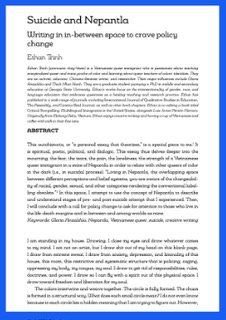By: Ethan Trinh
This autohistoria, or “a personal essay that theorizes,” is a special piece to me. It is spiritual, poetic, political, and dialogic. This essay thus delves deeper into the mourning, the fear, the tears, the pain, the loneliness, the strength of a Vietnamese queer immigrant in a state of Nepantla in order to relate with other queers of color in the dark (i.e., in suicidal process). “Living in Nepantla, the overlapping space between different perceptions and belief systems, you are aware of the changeability of racial, gender, sexual, and other categories rendering the conventional label-ling obsolete.” In this space, I attempt to use the concept of Nepantla to describe and understand stages of pre- and post-suicide attempt that I experienced. Then, I will conclude with a call for policy change to ask for attention to those who live in the life-death margins and in between and among worlds as mine.
LGBTQ Policy Journal






